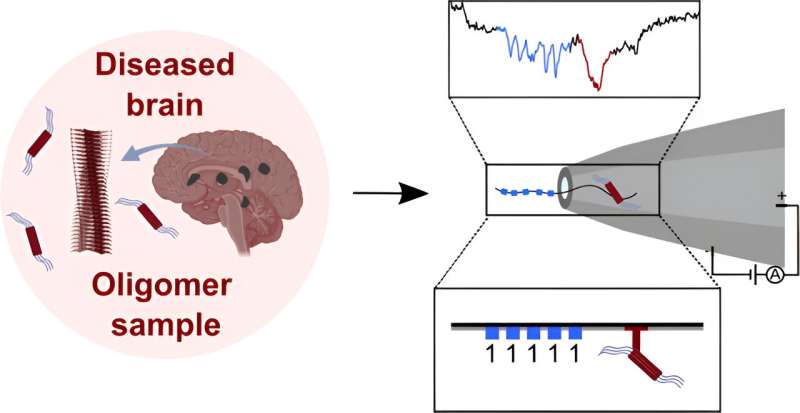December 5, 2023 report
This article has been reviewed according to Science X's editorial process and policies. Editors have highlighted the following attributes while ensuring the content's credibility:
fact-checked
peer-reviewed publication
trusted source
proofread
Using solid-state nanopores and DNA barcoding to identify misfolded proteins in neurodegenerative disorders

A team of chemists, microbiologists and physicists at the University of Cambridge in the U.K. has developed a way to use solid-state nanopores and multiplexed DNA barcoding to identify misfolded proteins such as those involved in neurodegenerative disorders in blood samples. In their study, reported in the Journal of the American Chemical Society, the group used multiplexed DNA barcoding techniques to overcome problems with nanopore filtering techniques for isolating harmful oligomers.
Prior research has shown that the presence of harmful oligomers in the brain can lead to misfolding of proteins associated with neurodegenerative diseases such as Parkinson's and Alzheimer's disease. Medical researchers have been looking for a way to detect them in the blood as a way to diagnose neurodegenerative disease and to track the progression once it has been confirmed.
Unfortunately, finding them in complex mixtures such as blood has proven to be a daunting task. One approach has shown promise—using nanopore sensors—but to date, they cannot track target oligomers as they speed through customizable solid-state nanopore sensors. In this new effort, the research team overcame this problem by using customizable DNA nanostructures.
In their work, the research team bound proteins to their custom-built DNA nanostructures as a means for creating a sort of "barcode" that could be used to identify molecules using the solid-state nanopore sensors. To use their barcode, they placed a bit of DNA that had been tagged with a chemical that binds only to the target oligomers, resulting in an additional spike, which allowed for isolating the target and its full characterization.
The team then tested their technique using oligomers of α-synuclein, the type of proteins involved in folding in Parkinson's disease, and were able to isolate them as desired under lab conditions. They also measured the rate of oligomer formation. They then tested the technique in an environment that was closer to biological conditions and found performance did not suffer. They suggest their technique offers the promise of a future screening process for patients at risk of developing neurodegenerative disorders.
More information: Sarah E. Sandler et al, Multiplexed Digital Characterization of Misfolded Protein Oligomers via Solid-State Nanopores, Journal of the American Chemical Society (2023). DOI: 10.1021/jacs.3c09335
Journal information: Journal of the American Chemical Society
© 2023 Science X Network




















